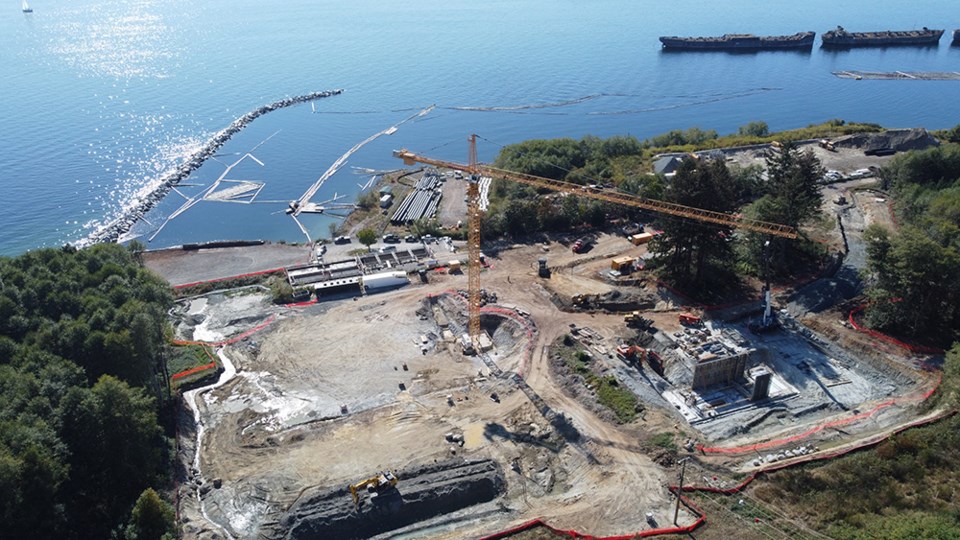City of Powell River councillors were urged to pursue tertiary treatment of the city’s wastewater with covers over the open sewage tanks.
At the December 14 committee of the whole meeting, councillors heard from Lesley Armstrong, who appeared as a delegation to express her concerns about contaminants of emerging concern (CECs).
Armstrong reminded councillors that they had sent a resolution to Association of Vancouver Island and Coastal Communities (AVICC) and Union of British Columbia Municipalities (UBCM), and on September 16, UBCM endorsed council’s resolution by an 86.5 per cent vote.
The resolution resolved that UBCM request the province and government of Canada to establish sampling protocols and introduce specific measures for monitoring and reducing levels of contaminants of emerging concern from wastewater treatment plants in order to prevent adverse effects to human and wildlife health in air, water and on land.
“Powell River’s most direct measure for reducing levels of CECs from wastewater treatment plants would be to utilize tertiary treatment, while a way to prevent adverse effects to human and wildlife health would be placing covers on the plant’s four open aeration tanks,” said Armstrong.
She said the presence of CECs represent a hazard to the community and that the humid and windy environment is optimal for aerosolization and transport of CECs. She added that CECs are comprised of natural and synthetic substances such as: bacteria, caffeine, personal products, cleaners, minerals, viruses, pesticides, makeup, herbicides, paint thinner, prescribed and illegal drugs and more.
“Canada’s current sewage discharge regulations predate knowledge of large numbers of CECs entering receiving environments and the growing negative effects on those environments,” said Armstrong.
She said many BC municipalities have upgraded to tertiary treatment, including Campbell River, Sechelt, Kamloops, Kelowna, Langley, Maple Ridge and Pitt Meadows, Richmond, Victoria and Vancouver/North Vancouver.
“Canada has a new federal environment minister who has a track record for making change,” said Armstrong. “Hopefully this will translate towards funding to upgrade our proposed secondary treatment plant to tertiary.”
Armstrong said the upfront cost of moving in this direction may appear daunting but will achieve positive economic returns in the collective future.
Councillor suggests letter
Councillor CaroleAnn Leishman asked if it would be beneficial for city council to forward a letter to federal and provincial ministers of environment, letting the federal minister know about the UBCM resolution. She didn’t believe there had yet been a provincial response to the resolution.
“If council was willing to entertain a letter, sending them the resolution language and encouraging some action on that, especially federally, I’d be happy to move that,” said Leishman.
Armstrong said that would be awesome and icing on the cake.
Councillor George Doubt said he believes it was a success when council passed the resolution and had it endorsed by the municipal associations.
“It asks the provincial and federal governments to establish guidelines about what the goal would be for the endpoint of that tertiary treatment option,” said Doubt. “We have to have those guidelines set by the provincial or federal governing authority so we would know what to ask people to design and then we could look at how much that was going to cost the taxpayers to do the design. The first step is to get those regulations.
“If council was to write a letter, copying yours, to the provincial and federal ministers involved, saying we’ve asked for these standards to be set, and would you please get on with it and do that as quickly as possible, that would give the city an opportunity to move forward.”
Armstrong said the 2018 federal wastewater panel’s findings were largely that the regulations were outdated and CECs were not factored in, nor the numbers and compounding effects of them.
“Why is it that so many other large centres are upgrading to tertiary without the regulations?” asked Armstrong. “There’s a lot of data out there showing how harmful CECs are.”
Palm provides monitoring committee update
Councillor Jim Palm said the presentation was timely. He said he had just got out of the liquid waste monitoring committee meeting with various residents and there was discussion about obstacles that have to be overcome to get the new plant built. He said the price tag on the plant is $89 million and the question was asked at the monitoring committee meeting in terms of the overall cost.
Palm said projections are for $4 or $5 million more on top of where the project is at now.
“Our staff is bending over backwards to make sure they are on top of every aspect of that build, financially, technically and supply chain-wise,” said Palm. “They are doing everything in their power to bring that in as close to budget as they can.
“I endorse your letter writing and we are going to be building that facility to the capacity where, with further research by the federal and provincial governments, and with more recommendations and regulations coming down the hill, we will have the capacity to upgrade that facility. We want to get that plant in place, so we are not discharging sewage into the strait in front of our lovely community.”
The committee gave unanimous consent to send the letter to the provincial and federal ministers of environment, copying the MLA and MP.


